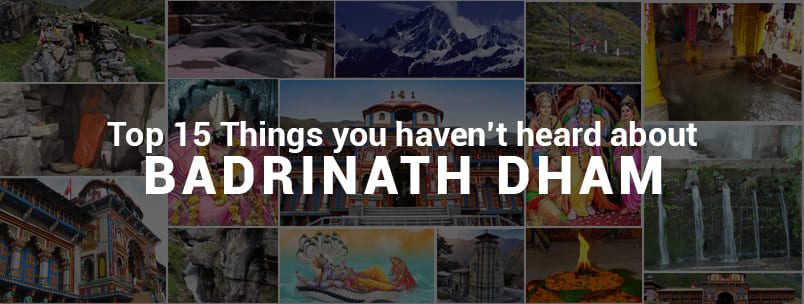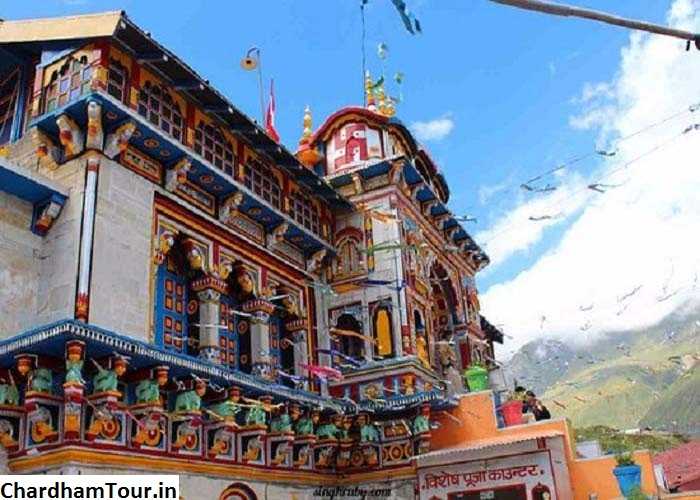Harmony of Bliss and serenity, Badrinath Dham is a divine abode of Lord Vishnu. Being a prominent Chota and Bada Char Dham site, this pilgrimage destination is the most visited place in India. Decked between the mighty Nar and Narayan mountain ranges, the temple of lord Badri captivates the heart with spiritual vibes and enchanting mountain views of the Garhwal Himalayas. Here is a list of the top 15 things you might not have heard about Badrinath Dham –

Integral Part of Bada and Chhota Char Dham
Badrinath is both a part of Bada Chardham (which is at four corners of India) and also of Chota Chardham (which is within Uttarakhand). There is a local proverb regarding the greatness of Badrinath. The proverb implies that one who viewed Lord Badrinath even once never returns to the mother’s womb, meaning that the holy view of Lord Badrinath gives Liberation from the Cycle of life and Death. For this reason, the scriptures recommend visiting Badrinath at least once in a lifetime.
Only the Idol Darshan in Kalyug
Alakananda River flows by the side of Badrinath as if washing away the holy feet of the Lord. The scriptures mention that in Satyug every organism could have the holy view of Lord Badrinath’s cosmic image, in Treta Yuga only pious hearts like saints and hermits, and in Dwaparyug when Lord Krishna, the incarnation of Lord Vishnu, took the mortal form he declared that in the next Yug, only the idol could be viewed.
Another Vaikuntha of Lord Vishnu
The scriptures mention Badrinath Dham as the second ‘Vaikuntha’ (the abode of Lord Vishnu). ‘Ksheer Sagar’ (the Milky Ocean) is one Vaikuntha and the other is Badrinath. It is believed that Lord Shiva used to reside here but Lord Vishnu sought this land from him.
The great bond of Nar and Narayana
Chardham Yatra starts from Gangotri from where the turbulent Ganga River emerges and ends at Badrinath. Badrinath is situated between two mountains – Nar and Narayana. It is believed two hermits named Nar and Narayana, both incarnations of Lord Vishnu in Satyug, meditated here and were born as Arjun and Krishna in Treta Yuga.
Connection of Narasimha Temple
It is believed that the Narasimha Temple in Joshimath has a connection with The Badrinath Temple. One of the arms of Narasimha is thinning away slowly but gradually. The day it breaks, locals believe that the Nar and Narayan mountains will merge and there will be no view of Lord Badrinath thereafter.
The name Badrinath
There is an interesting story behind the name ‘Badrinath’. Once, Devi Laxmi got angry with Vishnu and left for her father’s house. Later, pacified when she returned, she saw Lord Vishnu meditating in a forest of ‘Badri’ (jujube berry) trees. Amused, she named him Lord Badrinath.
Arrival of Bhavishya Badri
This Saraswati Temple is situated at the origin of River Saraswati near Mana Gaon, which is 3 km from Badrinath. This river flows for a while and then vanishes into Alaknanda River. It is a common belief that one day the present Badrinath will vanish and reappear at Bhavishya Badri.
Brahma Kapal and Lord Shiva’s Sin
It is a commonly held belief that Lord Shiva was released from the sin of ‘Brahma-Hatya’ (killing of Brahman) at Badrinath. The place is known as ‘Brahma Kapal’ which is a high rock pedestal where people pray for their ancestors with the belief that their ancestors will be liberated from the cycle of Life and Death.
The Rawals
The high priest of Badrinath is from the clan of Adi Shankaracharya. He is called ‘Rawal’. During his span as a priest, the Rawal cannot marry and has to be celibate. For them, even the touch of women is considered a sin. Before Rawals, Dandi Sanyasi Mahant performed all the rituals of Badrinath Temple.
The Divya Jyoti
The Divya Jyoti of Badrinath Dham will amaze your mind. Every year, before the closing of the portals of Badrinath Temple for six months due to heavy snowfall and winter, a Divya Jyoti (Diya) is illuminated to honor Lord Badrinath. Surprisingly, the Diya remains lit until the portal of Badrinath is open. It is believed that Lord Badrinath is protecting the divya light.
Different Yugas, Different Names
Badrinath Dham was known by different names under different Yugas. In Sat Yug, Badrinath was known as Muktiprada; In Treta Yug, Yogasiddha; In Dwapar Yug, Vishala and In Kali Yug, Badrinath or Badri Vishal.
Lord Ram’s Visit to Badrinath
Once Lord Rama visited Badrinath Dham for some time to pay homage to Lord Vishu after defeating demon king Ravana.
The Sacred Charanpaduka
The sacred Charanpaduka in Badrinath has immense religious and spiritual significance for Hindu Devotees. The place Charanpaduka translates to the “Footprints of Lord Vishnu”. It is said that Lord Vishnu descended from Vaikunth to bless the earth and in that process, his footprints were etched on this place which is known as Charanpaduka.
Tapt Kund, Sacred Bathing Ritual
Located in proximity to Badrinath, the thermal springs – Tapt Kund in Badrinath is a sacred place to visit before the darshan of Badrinath Dham Temple. Taking a holy dip in the water of this Kund is believed to be auspicious. It is believed that the holy dip will relieve the devotees from all their sins.
Panch Dharas
You must visit the group of 5 sacred Dharas (streams) named as Panch Dharas. These 5 Dharas are known as Indira Dhara which is 1.5 km from Badrinath temple; Urvashi Dhara which is located at the right of the Ganga River; Bhrigu Dhara passes through many caves; Kurma Dhara which has extremely cold waters and the lukewarm water of Prahlad Dhara. It’s an offbeat gem of Badrinath Dham which you must visit to get awesome views of the mountains.






Leave a Reply